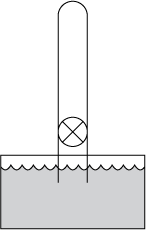- Joined
- Jul 28, 2018
- Messages
- 276
- Reaction score
- 145
A tall tube is evacuated, and its stopcock closed. The open end of the tube is immersed into a container of water (density 103 kg/m3) that is open to the atmosphere (pressure 105 N/m2).

When the stopcock is opened, how far up the tube will the water rise?
So I got the question right, and I thought my logic was sound, the AAMC kinda had me second guessing my logic though, and I was wondering if someone could confirm whether it sounds conceptually sound. The AAMC basically said "P= (p)(g)(h). Okay.
My logic was that I manipulated Bernoulli's equation:
P + pgh + 1/2pv^2 = P + pgh + 1/2pv^2
1) we are dealing with stationary fluids. hence no kinetic energy. So we get:
P + pgh = P + pgh
The fluid in the "bowl" technically has a height of 0 relative to the tube, so we can take "pgh" out of one half:
P + pgh= P
Technically the pressure in a "vacuumed" evacuated tube is negligible, so assume 0... giving us
P= (p)(g)(h)
Hope I can get some verification from some of you physics gurus out there whether or not my logic was sound or I just got lucky, Thanks!

When the stopcock is opened, how far up the tube will the water rise?
- A. 1 m
- B. 5 m
- C. 10 m
- D. 20 m
So I got the question right, and I thought my logic was sound, the AAMC kinda had me second guessing my logic though, and I was wondering if someone could confirm whether it sounds conceptually sound. The AAMC basically said "P= (p)(g)(h). Okay.
My logic was that I manipulated Bernoulli's equation:
P + pgh + 1/2pv^2 = P + pgh + 1/2pv^2
1) we are dealing with stationary fluids. hence no kinetic energy. So we get:
P + pgh = P + pgh
The fluid in the "bowl" technically has a height of 0 relative to the tube, so we can take "pgh" out of one half:
P + pgh= P
Technically the pressure in a "vacuumed" evacuated tube is negligible, so assume 0... giving us
P= (p)(g)(h)
Hope I can get some verification from some of you physics gurus out there whether or not my logic was sound or I just got lucky, Thanks!
